Publisher: UNHCR Year: 2017 Description: This document evaluates various sampling strategies that can be used during the emergency phase to estimate the status of WASH services in refugee camps or settlements. The working paper presents the results of statistical analyses carried out on real data from Ethiopia. The objective of the study was to evaluate […]
Archives
Rapid Methods for Assessing Water, Sanitation and Hygiene (WASH) Services in Emergency Settings (UNHCR, 2017b)

Rapid Methods for Assessing Water, Sanitation and Hygiene (WASH) Services in Emergency Settings (UNHCR, 2017a)
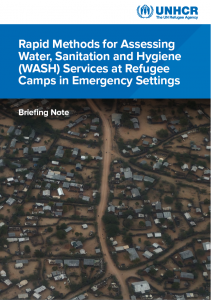
Cash Based Interventions for WASH Programmes in Refugee Settings (UNHCR, 2016)
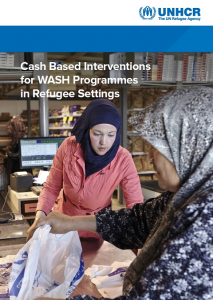
This report is based on a desk-based review of secondary data, comprising published material as well as grey literature, supplemented with key informant interviews for programmes that lacked documentation. Section One summarises the current use of CBI in WASH programming. Section Two summarises the best practices and lessons learned including challenges faced, drawing on evidence from the project examples found. Section Three provides recommendations and best practice guidance for use of CBI in refugee settings. Section Four details existing tools and guidance.
- Tags: CASH Interventions. Categories: WASH Research Documents and WASH Research Documents.
UNHCR WASH Monthly Report Card Guidelines (UNHCR, 2016)

This document provides guidance on how to access the WASH Report Card within TWINE, and fill in the different fields with the right information, with examples for easy comprehension.
- Tags: WASH Reporting and WASH Reporting.
F-200/2015a Summary of Important WASH Diseases in Refugee Settings (UNHCR, 2015)

This document provides a quick summary of the most important WASH related diseases for refugee settings and includes a list of recommended control strategies.
- Tags: Bloody Diarrhoea, Communicable Disease Control, Handwashing with Soap, and Watery Diarrhoea. Categories: WASH Blank Forms.
UNHCR Global Strategy for Public Health 2014 – 2018 (UNHCR, 2014)

This document describes UNHCR’s global strategy for public health through a set of guiding principles and strategic approaches including protection; age, gender and diversity; equity; access; sustainability; community empowerment; appropriateness and reliability; partnerships and coordination; capacity building; communication and advocacy; integrated approaches; measurement and monitoring; and innovation. The document describes strategic objectives and enabling actions per sub-sector (Public Health, HIV and Reproductive Health, Food Security and Nutrition, and WASH).
WASH Winterization Technical Brief (UNHCR, 2015)
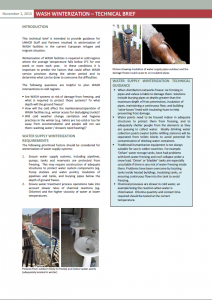
This technical brief is intended to provide guidance for UNHCR staff and Partners involved in winterization of WASH facilities in the current European refugee and migrant situation.
- Tags: Bathing Facilities, Cold Climates, Hygiene Promotion, Hygiene Promotion, and Hygiene Promotion. Locations: Central Europe and the Baltic States, Eastern Europe, and Europe. Categories: WASH Emergency Guidelines and WASH Emergency Tools.
OG-802 Operational Guidelines for Staff Health and Safety in Refugee WASH Programmes (UNHCR, 2015)
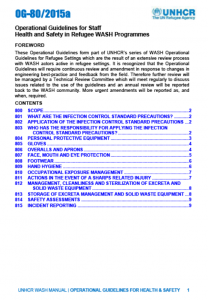
This document provides health and safety guidelines for refugee WASH programmes for staff are involved in either: cleaning of toilets; maintenance of toilets; desludging of toilets; the collection and movement of excreta; the collection or movement of solid wastes; the handling of vector control or water treatment chemicals; any staff who may potentially come into contact with excreta, sewage, wastewater, solid waste, medical waste or any other sources of (potential) infection.
DG-400 Design Guidelines for Toilets in Refugee Settings (UNHCR, 2015)
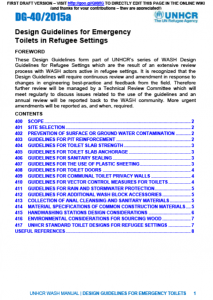
This document contains guidelines for toilets in refugee settings including: site selection; prevention of surface or ground water contamination; pit reinforcement; toilet slab strength; toilet slab anchorage; sanitary sealing; use of plastic sheeting; toilet doors; privacy walls; vector control measures; rain and stormwater protection; wash block accessories; collection of anal cleansing and sanitary materials; material specifications; handwashing stations design considerations; and environmental considerations for sourcing wood .
DG-300 Design Guidelines for Piped Water Networks in Refugee Settings (UNHCR, 2015)
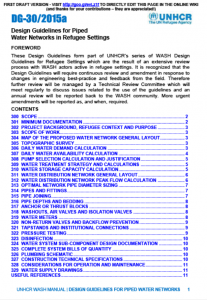
This document contains guidelines to help UNHCR and WASH actors design piped water networks in refugee settings. It describes the minimum documentation that should be included for a water network design project.
- Tags: Piped Water Networks, Piped Water Networks, WASH Monitoring, WASH Monitoring, WASH Monitoring, WASH Monitoring, WASH Monitoring, WASH Monitoring, WASH Programme Management, WASH Programme Management, WASH Programme Management, WASH Programme Management, WASH Strategy Development, WASH Strategy Development, WASH Strategy Development, WASH Strategy Development, Water Pumping, Water Storage, Water Supply, Water Supply, Water Supply, and Water Supply. Languages: English, English, English, English, English, English, English, English, English, and English. Organisations: UNHCR, UNHCR, UNHCR, UNHCR, UNHCR, UNHCR, UNHCR, UNHCR, UNHCR, and UNHCR. Categories: WASH Design Guidelines, WASH Design Guidelines, WASH Policy Guidelines, WASH Policy Guidelines, WASH Policy Guidelines, WASH Policy Guidelines, WASH Policy Guidelines, WASH Reference Documents, WASH Reference Documents, WASH Reference Documents, WASH Reference Documents, WASH Reference Documents, WASH Reference Documents, WASH Reference Documents, WASH Reference Documents, WASH Technical Designs, and WASH Technical Designs.
 English
English
